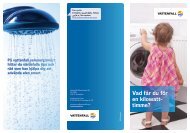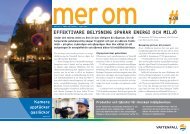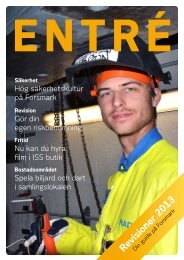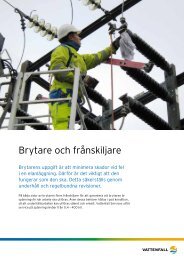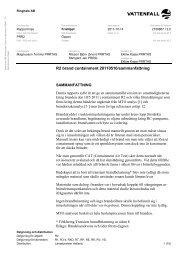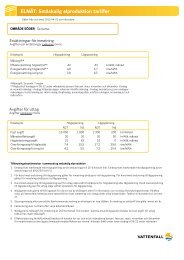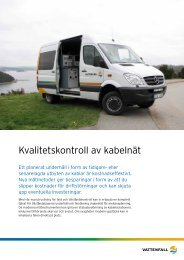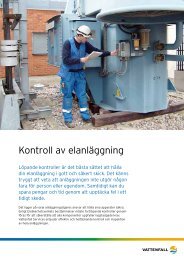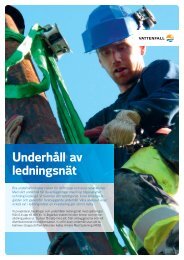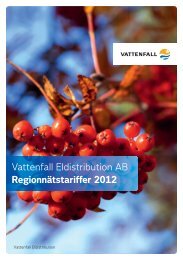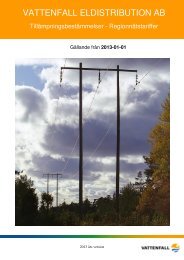This environmental impact assessment for Kriegers flak ... - Vattenfall
This environmental impact assessment for Kriegers flak ... - Vattenfall
This environmental impact assessment for Kriegers flak ... - Vattenfall
Create successful ePaper yourself
Turn your PDF publications into a flip-book with our unique Google optimized e-Paper software.
118 CONSEQUENSES OF THE WIND FARM<br />
In most cases, noise from the wind turbines will not<br />
be distinguishable at closer distances as the background<br />
noise from waves and the wind is high when<br />
the turbines operate.<br />
Transports by helicopter and ships that are necessary<br />
<strong>for</strong> service and repairs of the turbines, will not<br />
signiÞ cantly increase the disturbance level as the area<br />
is subjected to trafÞ c already.<br />
b) Shadows<br />
The shadows that will arise due to the wind farm will<br />
reach maximum 2 000 metres from the turbines (see<br />
Chapter 5.7.2.4) and will thus not have an <strong>impact</strong> on<br />
humans onshore. Due to the temporary character of the<br />
shadows, <strong>impact</strong> on humans in passing boats will be<br />
small.<br />
c) Accidents/oil spill<br />
There are reports of blades/part of blades having come<br />
loose, of Þ re and of towers collapsing but these are<br />
very rare. Experience from operating turbines show<br />
that it is mainly ß aws in steering and control that may<br />
cause accidents.<br />
The risk of ice covering should not be underestimated.<br />
When a turbine is started after standstill, the<br />
ice cover is normally shaken off and the ice falls down<br />
along the tower. As an exception, sheets of ice can be<br />
thrown from the blades.<br />
The risk of turbines collapsing, that parts of the turbine<br />
comes lose or that ice is thrown off is very small.<br />
As the farm is 30 km away from the nearest house,<br />
there is no risk <strong>for</strong> humans that are ashore. There is,<br />
however, a risk <strong>for</strong> humans that are inside the farm<br />
area, but as humans normally don’t frequent the area<br />
or the vicinity thereof, the third party risk is minimal.<br />
Those affected, may be service personnel and Þ shermen.<br />
Oils and chemicals in the turbines are sealed off and<br />
secondary containers will prevent leakage into the sea<br />
in case of an accident.<br />
Boat trafÞ c to and from the area will be intensive<br />
during the construction and dismantling phases. During<br />
this time, there is a risk of oil and material spill,<br />
especially when laying the foundations. Small spills of<br />
this kind will not have an <strong>impact</strong> on human health.<br />
If a ship collision would occur, this could lead to big<br />
oil or chemical spills that, in turn, could have a nega-<br />
tive <strong>impact</strong> on human health.<br />
The risk of accidents that cause oil spills, has been<br />
calculated by SSPA to 0,0006 per year, or about 1<br />
700 years between collisions (to be compared to the<br />
number that has been calculated <strong>for</strong> the wind farm in<br />
the German economic zone, namely 580 years).<br />
The average oil spill has been estimated to 3 400 tons.<br />
With security increasing measures, such as tugboats<br />
on standby, the risk decreases to 0,00015 collisions per<br />
year or about 6700 years between collisions (see Attachment<br />
12.2).<br />
SSPA has also calculated the risk of humans being<br />
injured due to ships colliding with the wind farm. In<br />
this case, the risk of accidents has been estimated to<br />
0,000002 per year, or, provided no security increasing<br />
measures are taken, one every 500 000 years. A<br />
comparison with the European ferry trafÞ c shows that<br />
the collision risk between ferries and wind turbines<br />
is much smaller. With security increasing measures<br />
such as AIS and trafÞ c control, the risk is reduced to<br />
0,0000005 personal accident cases per year, or one<br />
every 2000000 years.<br />
Summary of <strong>impact</strong> on humans.<br />
The wind farm is situated far from shore resulting in<br />
no shadows reaching the shore. Also, no noise from the<br />
turbines will be hearable onshore.<br />
The risk of humans being injured due to falling ice<br />
or from parts of a turbine are minimal.<br />
If an accident occurs, <strong>for</strong> example a ship colliding<br />
with a turbine, oil from the turbine and the ship could<br />
leak out and cause large negative effects. The risk<br />
thereof is, however, very small. The risk of personal injury<br />
at such an accident is also considered as minimal.<br />
12.1.2 Mitigating measures<br />
A security zone will be created around the wind farm<br />
and the turbines will be marked so as to be seen from<br />
passing ships.<br />
To avoid leakage, the oils and chemicals in the<br />
turbines are hermetically sealed and a secondary container<br />
will prevent any leakage from reaching the sea.<br />
In case of oil still leaking out, there will be specially<br />
prepared routines to handle smaller leakages from plat<strong>for</strong>ms<br />
and boats as well as an action plan <strong>for</strong> contact<br />
with the Coast Guard in case of an oil or chemical spill<br />
into the sea.




